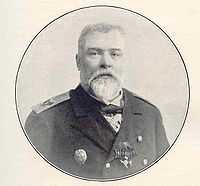Nikolai Nebogatov
| Nikolai Nebogatov | |
|---|---|
 Nikolai Nebogatov | |
| Native name | Николай Иванович Небогатов |
| Born | April 20, 1849 |
| Died |
August 4, 1922 (aged 73) Moscow |
| Allegiance |
|
| Service/branch |
|
| Years of service | 1869-1905 |
| Rank | Rear Admiral |
| Commands held | 3rd Pacific Squadron |
| Battles/wars | Russo Japanese War |
Nikolai Ivanovich Nebogatov (Russian: Николай Иванович Небогатов occasionally transliterated as Nebogatoff, (April 20, 1849 – August 4, 1922) was a Rear-Admiral in the Imperial Russian Navy, noted for his role in the final stages of the Russo-Japanese War of 1904-1905.
Biography
Nebogatov graduated from the Sea Cadets Corps in 1869, and was promoted to lieutenant in 1874. In 1882-86 he was executive officer aboard the cruiser Razboinik and in 1888 was given command of the gunboat Groza, followed in 1889, by the gunboat Grad. He was in command of numerous Russian warships during his career, including the cruisers Krejs, Admiral Nakhimov (1896), and Minin. He was then appointed head of naval artillery training for the Russian Baltic Fleet, and was promoted to rear admiral in 1901.
During the Russo-Japanese War, the bulk of the Russian Baltic Fleet was renamed the "Second Pacific Squadron", and set sail under the command of Admiral Zinovy Rozhestvensky on an epic journey to relieve the Russian Pacific Fleet, trapped at the Battle of Port Arthur by the Imperial Japanese Navy. Largely for political reasons, calls were made for a "Third Pacific Squadron", consisting of mostly obsolete cruisers and coastal defence battleship to supplement the Second Pacific Squadron. Realizing that the ships were highly unsuited for the task, and faced with untrained crews, a number of Russian admirals refused the command; however, Nebogatov accepted the challenge. Despite several incidents of sabotage by pro-revolutionary or anarchist elements within the crews, Nebogatov sailed in February 1905 with the old battleship Imperator Nikolai I (as flagship), cruiser Vladimir Monomakh, and coastal-defense battleships Admiral Ushakov, Admiral Senyavin, and General Admiral Graf Apraxin, as well as numerous transport ships. The squadron passed through the Suez Canal and crossed the Indian Ocean to rendezvous with the Second Pacific Squadron at Cam Ranh Bay, French Indochina.
During the Battle of Tsushima, the Japanese fleet concentrated its efforts against the Second Pacific Squadron, so Nebogatov's ships survived the fate of Rozhestvenski's battleships during the first day or battle. With Rozhestvenski seriously wounded, and most of the Second Pacific Squadron's warships sunk or lost, Nebogatov took over command. Realizing that his ships were no match for the Japanese fleet, and that the Russian cruiser division under Admiral Oskar Enkvist would not arrive in time to prevent his annihilation, Nebogatov accepted Admiral Togo Heihachiro's surrender terms, and on May 28, 1905, he surrendered five of his remaining warships: battleships Nikolai I, Oryol, General Admiral Graf Apraxin, and Admiral Senyavin to the Japanese. The decision was opposed by many of his officers, and Captain Vasili Fersen of the cruiser Izumrud disobeyed orders and escaped through the Japanese lines. The captain of the battleship Admiral Ushakov, having become lost during the night, was unaware of the orders to surrender, and was sunk the next morning, out-gunned and outnumbered, by the Japanese fleet.
Nebogatov was taken as a prisoner of war by the Japanese, and while a prisoner was dishonorably discharged by the Russian Admiralty. On his return to Russia, he and 77 of his subordinate officers were arrested and taken before a court martial in December 1906. Nebogatov and three of his captains were sentenced to death by firing squad on December 25, 1906, but the sentences were commuted to 10 years in prison by order of Tsar Nicholas. He was released from the prison fortress of Sts. Peter and Paul in May 1909, when he was freed on the occasion of the tsar's birthday.
Nebogatov subsequently moved to Moscow, where he died in 1922.
Nebogatov was married to Nadezhda Petrovna and had two daughters and one son.
References
In English
- Connaughton, R.M (1988). The War of the Rising Sun and the Tumbling Bear—A Military History of the Russo-Japanese War 1904–5, London, ISBN 0-415-00906-5.
- Jukes, Geoffry. The Russo-Japanese War 1904–1905. Osprey Essential Histories. (2002). ISBN 978-1-84176-446-7.
- Warner, Denis & Peggy. The Tide at Sunrise, A History of the Russo-Japanese War 1904–1905. (1975). ISBN 0-7146-5256-3.
- Bio at Russojapanesewar.com
In Russian Language
- Russian Biographical Dictionary,
- Чегодаев-Саконский А. П. На «Алмазе». От Либавы через Цусиму — во Владивосток
- (Фото)
- Материалы судебного дела о сдаче эскадры Небогатова